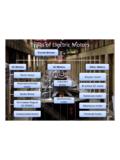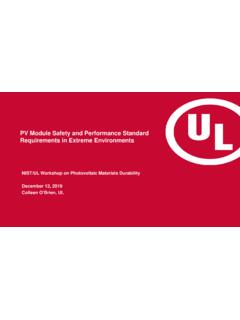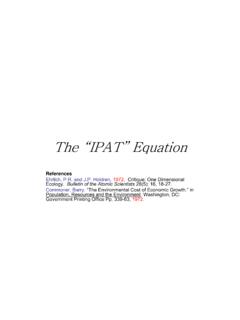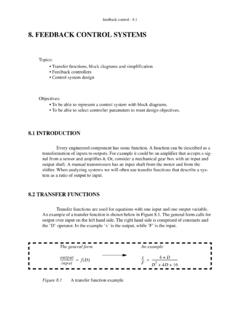Transcription of 2.0 RADAR RANGE EQUATION - UAH - Engineering
1 2011 M. C. Budge, Jr 1 RADAR RANGE EQUATION INTRODUCTION One of the simpler equations of RADAR theory is the RADAR RANGE EQUATION . Although it is one of the simpler equations , ironically, it is an EQUATION that few RADAR analysts understand and many RADAR analysts misuse. The problem lies not with the EQUATION itself but with the various terms that make-up the EQUATION . It is my belief that if one really understands the RADAR RANGE EQUATION one will have a very solid foundation in the fundamentals of RADAR theory. Because of the difficulties associated with using and understanding the RADAR RANGE EQUATION we will devote considerable class time to it and to the things it impacts, like detection theory, matched filters and the ambiguity function. BASIC RADAR RANGE EQUATION One form of the basic RADAR RANGE EQUATION is 23404 STTRNnPP G GSNRPR kT BF L (2-1) where SNR is termed the signal-to-noise ratio and has the units of watts/watt, or w/w.
2 SP is the signal power at some point in the RADAR receiver usually at the output of the matched filter or the signal processor. It has the units of watts (w). NP is the noise power at the same point that SP is specified and has the units of watts. TP is termed the peak transmit power and is the average power when the RADAR is transmitting a signal. TP can be specified at the output of the transmitter or at some other point like the output of the antenna feed. It has the units of watts TG is the directive gain of the transmit antenna and has the units of w/w. RG is the directive gain of the receive antenna and has the units of w/w. Usually, TRGG for monostatic radars. is the RADAR wavelength (see EQUATION (1-25) of the RADAR Basics chapter) and has the units of meters (m). is the target RADAR cross-section or RCS and has the units of square meters or m2.
3 R is the RANGE from the RADAR to the target and has the units of meters. 2011 M. C. Budge, Jr 2 k is Boltzman s constant and is equal to 10 w Hz K . 0T denotes a reference temperature in degrees Kelvin K. We take 0290 KT and usually use the approximation 2104 10 w/HzkT . B is the effective noise bandwidth of the RADAR and has the units of Hz. I emphasized the word effective because this point is extremely important and often misunderstood and misused by RADAR analysts. nF is the RADAR noise figure and is dimensionless, or has the units of w/w. L is a term included to account for all losses that must be considered when using the RADAR RANGE EQUATION . It accounts for losses that apply to the signal and not the noise. L has the units of w/w. L accounts for a multitude of factors that degrade RADAR performance.
4 These factors include those related to the RADAR itself, the environment in which the RADAR operates, the RADAR operators and, often, the ignorance of the RADAR analyst. We will spend the next several pages deriving the RADAR RANGE EQUATION and attempting to carefully explain its various terms and their origins. We will start by deriving SP, or the signal power component and follow this by a derivation NP, or the noise component. Derivation of SP The Transmitter We will start at the transmitter output and go through the waveguide and antenna and out into space, see Figure 2-1. For now, we assume that the RADAR is in free space. We can account for the effects of the atmosphere at a later date. We assume that the transmitter generates a single, rectangular pulse (a standard assumption) at some carrier frequency, cf. A sketch of the pulse (the terminology we use) is contained in Figure 2-2.
5 The average power in the signal over the duration of the pulse is termed the peak transmit power and is denoted as TP. The reason we term this power the peak transmit power is that we will later want to consider the transmit power averaged over many pulses. Figure 2-1 Transmit Section of a RADAR 2011 M. C. Budge, Jr 3 Figure 2-2 Depiction of a Transmit Pulse The waveguide of Figure 2-1 carries the signal from the transmitter to the antenna feed input. The only feature of the waveguide that is of interest in the RADAR RANGE EQUATION is the fact that it is a lossy device that attenuates the signal. Although we only refer to the waveguide here, in a practical RADAR there are several devices between the transmitter and antenna feed. We lump all of these into a conceptual waveguide. Since the waveguide is a lossy device we characterize it in terms of its loss which we denote as tL and term transmit loss.
6 Since tL is a loss it is greater than unity. With this, the power at the input to the feed is wTradtPPL (2-2) and is termed the radiated power. We assume that the feed and the antenna are ideal and thus introduce no additional losses to the radiated power. In actuality, the antenna assembly (antenna and feed) will have losses associated with it. These losses are incorporated in tL. Because of the above assumption, the power radiated into space is radP. The Antenna The purpose of the RADAR antenna is to concentrate, or focus, the radiated power in a small angular sector of space. In this fashion, the RADAR antenna works much as the reflector in a flashlight. As with a flashlight, a RADAR antenna doesn t perfectly focus the beam. However, for now we will assume it does. Later, we will account for the fact that the focusing isn t perfect by a scaling term.
7 With the above, we assume that all of the radiated power is concentrated in an area, beamA, as indicated in Figure 2-3. Therefore, the power density over beamA is 2 w/mradTtRbeambeamPP LSAA . (2-3) 2011 M. C. Budge, Jr 4 To carry EQUATION (2-3) to the next step we need an EQUATION for beamA. Given that the lengths of the major and minor axes of the ellipse in Figure 2-3 are AR and BR , we can write the area of the ellipse as 22 m4ellipseA BAR . (2-4) Figure 2-3 Radiation Sphere with Antenna Beam We next recognize that the power is not uniformly distributed across ellipseA and that some of the power will spill out of the area ellipseA. We account for this by replacing 4 with a constant AK, which will be less than 4 . We will further discuss AK shortly. With this we write beamA as 22 mbeamAA BAK R . (2-5) If we substitute EQUATION (2-5) into EQUATION (2-3) we get 22 w/mTtRAA BPLSKR.
8 (2-6) At this point we define a term, TG, that we call the transmit antenna gain as 2011 M. C. Budge, Jr 5 4 w/wTA A BGK (2-7) and use it to rewrite EQUATION (2-6) as 22 w/m4 TTRtGPSRL . (2-8) As it is used here, TG, is termed directive With this form of the antenna gain, it is assumed that if there are losses in the feed or the antenna itself, these losses will be included as separate loss terms in the RADAR RANGE EQUATION (losses will be discussed in a later section). Some analysts include the feed and antenna losses in the transmit antenna gain and term the result the power gain of the antenna. We will not do that here since it can lead to confusion when using EQUATION (2-7) and a form of directive gain to be presented shortly. Effective Radiated Power We now want to discuss a quantity termed effective radiated power.
9 To do so we ask the question: What power would we need at the feed of an isotropic radiator to get a power density of RS at all points on a sphere of radius R? An isotropic radiator is an antenna that does not focus energy; instead it distributes power uniformly over the surface of a sphere centered on the antenna. We can think of an isotropic radiator as a point source radiator. We note that an isotropic radiator cannot exist in the real world . However, it is a mathematical and conceptual concept that we often use in RADAR theory, like the impulse function is in mathematical theory. If we denote the effective radiated power as effP and realize that the surface area of a sphere of radius R is 24R we can write the power density on the surface of the sphere as 22 w/m4effRPSR . (2-9) If we equate EQUATION (2-8) and EQUATION (2-9) we obtain w TTefftantPGPERPLL (2-10) as the effective radiated power, or ERP.
10 In this EQUATION , the losses in the feed and/or antenna are included as the antL term. Some RADAR analysts think that the power at the output of a RADAR antenna is the ERP. IT IS NOT. The power at the output of the antenna is TtantP L L. All the antenna does if focus this power over a relatively small angular sector. 1 Skolnik, M. I., Introduction to RADAR Systems, Third Edition, 2001, McGraw-Hill, New York, 2011 M. C. Budge, Jr 6 Another note is that the development above makes the tacit assumption that the antenna is pointed exactly at the target. If the antenna is not pointed at the target, TG must be modified to account for this. We do this by means of an antenna pattern which is a function that gives the value of TG at all possible angles of the target relative to where the antenna is pointing.















